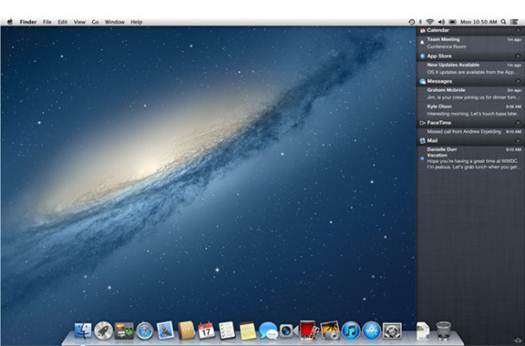Whenever a new Mac operating system comes
out, Macworld’s editors madly scramble around, looking for tips and tricks that
will make using that OS easier and more efficient. Macworld’s readers do
exactly the same thing. To be perfectly honest, they often beat us to the punch
on finding many of those tips and tricks. So this time around, with OS X
Mountain Lion, we decided to go straight to you, the reader, for ideas on
making the most of Apple’s latest Mac operating system.
More specifically, we scoured the postings
on the Mac OS X Hints website (hints.macworld.com), where all kinds of users
post all kinds of tips. Every month, we use the best of those tips in our Mac
OS X Hints column; this month, we had so many tips for Mountain Lion that we
decided to devote a whole feature to them.

So
this time around, with OS X Mountain Lion, we decided to go straight to you,
the reader, for ideas on making the most of Apple’s latest Mac operating
system.
These range from basic to advanced. Some we
were already aware of but decided to pass along just in case you didn’t, while
others were new to us. In either case, if you’ve already upgraded to Mountain
Lion, you should find some tricks and techniques here that will help you get
more out of Apple’s latest operating system right away. If you haven’t made
that leap yet, save this story until you upgrade.
The System
Three Quick Ways to View Notification
Center
You can open Notification Center by
clicking its icon in the menu bar, but here are three other ways to display it:
1. Swipe with two fingers from the right edge of your trackpad to the
left.
2. Another option is to use a hot corner. To activate this, go to
either the Desktop & Screensaver pane or the Mission Control pane in System
Preferences, and click the Hot Corners button. Choose Notification Center from
the drop down menu for the corner you want to use — you can now open
Notification Center by moving your cursor there. To close it click elsewhere
onscreen or move your cursor back to the corner.
3. The third method involves setting a keyboard shortcut. In the
Keyboard preference pane, click the Keyboard Shortcuts tab, and then Mission
Control. Notification Center is listed in that section; select its checkbox to
add a shortcut, and type the shortcut in the field that appears.
Temporarily Hide Alerts and
Notifications
If you’re overwhelmed by the number of
notifications you get, you can pause them with one click. Press Option while
clicking the Notification Center icon at the right end of the menu bar. This
pauses them until the next day.
Alternatively, if you scroll down when
Notification Center is visible, you’ll see a Show Alerts And Banners switch
that you can toggle off. To reactive Notification center, Option-click the same
icon again or toggle the Show Alerts And Banners switch on.

If
you’re overwhelmed by the number of notifications you get, you can pause them
with one click.
Pinch To Zoom In Quick Look
In Mountain Lion, you can use two finger
pinch and spread gestures to change the way the files you’re previewing are
displayed. When you use Quick Look to view PDFs and web archives, spreading two
fingers apart zooms in: pinching them together zooms out. (Oddly, these
gestures don’t work with graphics files.)
With other file types, those gestures
behave as they did in OS X Lion: spreading switches you to full-screen view,
and pinching returns you to a regular window. To switch to full- screen mode
when using Quick Look with a PDF or web archive in Mountain Lion, move the
cursor to the title bar and spread your fingers. However, you can’t pinch to
exit full-screen mode with these types of files.
Restore the RSS Visualizer Screensaver
Mountain Lion no longer includes the RSS
Visualizer screensaver, but you can copy it from a Mac running Lion. On that
other computer, go to /System/Library/Screen Savers and find the file RSS
Visualizer.qtz. Copy it to youruserfolder/Library/Screen Savers on the Mac
running Mountain Lion. (Create that folder if necessary.) You can now select
this screensaver from the Desktop & Screen Saver pane in System Preferences.
Keep Your Mac Awake
With Mountain Lion, you may have found that
your Mac goes to sleep when you don’t want it to. You may, for example, have
configured your Energy Saver preferences to put your Mac to sleep after 15
minutes of inactivity. Unfortunately, this can result in your Mac going to
sleep even if there’s an active process, such as a download, in progress. Some
have even reported this happening when they change the sleep setting to Never.
There is a solution in the form of a
command, caffeinate. To implement it, type the following command in Terminal:
caffeinate -u -t 3600. The 3600 there indicates the number of seconds before
the system’s sleep settings go into effect; in this case, the 15-minute
countdown to sleep won’t begin until 3,600 seconds have passed.
You can also run the command without the
time switch; in that case, your Mac will stay awake until you press Control-C
in Terminal.

With
Mountain Lion, you may have found that your Mac goes to sleep when you don’t
want it to.
Select an AirPlay Device from the Menu
Bar
The standard way to play your Mac’s audio
over an AirPlay device is to open System Preferences, click on the Sound pane’s
Output tab and select the device.
There is, however, a quicker way. Have the
Volume menu visible in the menu bar, and hold down the Option key while you
click on its icon. That will enable you to select audio inputs and outputs.
Unfortunately, this menu displays only the last selected AirPlay device, If you
don’t want to use that one, you’ll need to revisit the Sound preference pane.